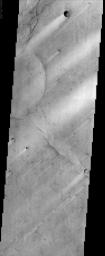- Original Caption Released with Image:
-

(Released 6 June 2002)
The Science
This image, located near the equator and 288W (72E), is near the southern edge of a low, broad volcanic feature called Syrtis Major. A close look at this image reveals a wrinkly texture that indicates a very rough surface that is associated with the lava flows that cover this region. On a larger scale, there are numerous bright streaks that trail topographic features such as craters. These bright streaks are in the wind shadows of the craters where dust that settles onto the surface is not as easily scoured away. It is important to note that these streaks are only bright in a relative sense to the surrounding image. Syrtis Major is one of the darkest regions on Mars and it is as dark as fresh basalt flows or dunes are on Earth.
The Story
Cool! It almost looks as if nature has "painted" comets on the surface of Mars, using craters as comet cores and dust as streaky tails. Of course, that's just an illusion. As in many areas of Mars, the wind is behind the creation of such fantastic landforms. The natural phenomenon seen here gives this particular surface of Mars a very dynamic, fast-moving, almost luminous "cosmic personality."
The bright, powdery-looking streaks of dust are in the "wind shadows" of craters, where dust that settles onto the surface is not as easily scoured away. That's because the wind moves across the land in a particular direction, and a raised surface like the rim of a crater "protects" dust from being completely blown away on the other side. The raised landforms basically act as a buffer. From the streaks seen above, you can tell the wind was blowing in a northeast to southwest direction.
Why are the streaks so bright? Because they contrast with the really dark underlying terrain in this volcanic area of Mars. Syrtis Major is one of the darkest regions on Mars because it is made of basalt. Basalt is typically dark gray or black, and forms when a certain type of molten lava cools. The meaning of the word basalt has been traced back to an ancient Ethiopian word "basal," which means "a rock from which you can obtain iron." That must have made it a very desired material with ancient Earth civilizations long ago.
Basalt is actually one of the most abundant types of rock found on Earth. Most of the volcanic islands in the ocean are made of basalt, including the large shield volcano of Mauna Loa, Hawaii, which is often compared to Martian shield volcanoes. Shield volcanoes don't have high, steep, mountain-like sides, but are instead low and broad humps upon the surface. They're created when highly fluid, molten-basalt flows spread out over wide areas. Over several millennia of basaltic layering upon layering, these volcanoes can reach massive sizes like the ones seen on Mars. You can see the wrinkly texture of dark lava flows (now hard and cool) in the above image beneath the brighter dust.
- Image Credit:
-
NASA/JPL/Arizona State University
Image Addition Date: -
2002-06-17
|

 Planetary Data System
Planetary Data System













